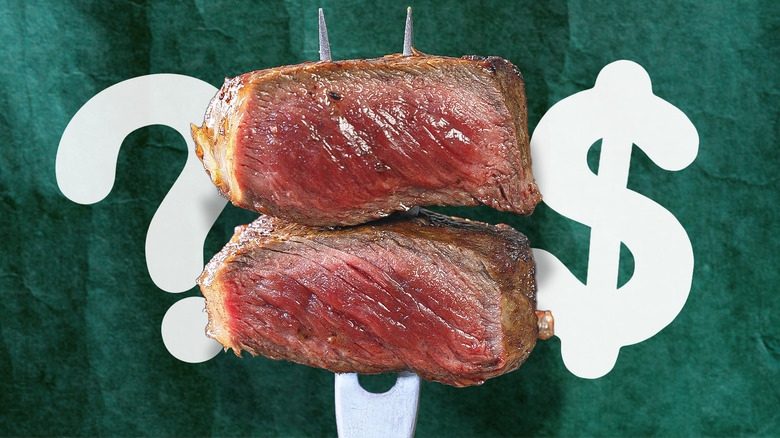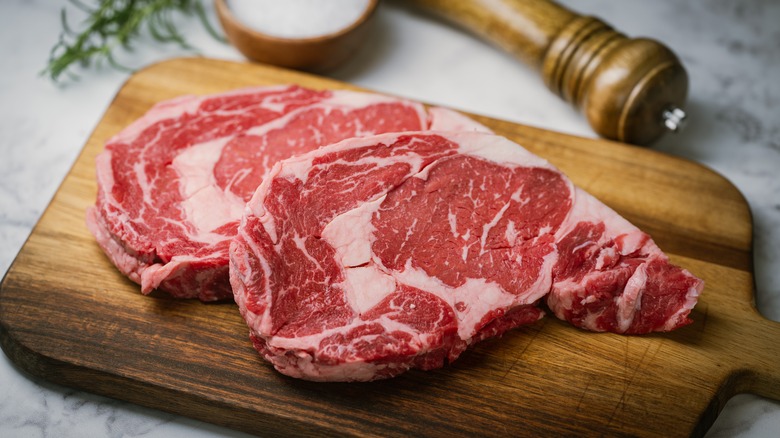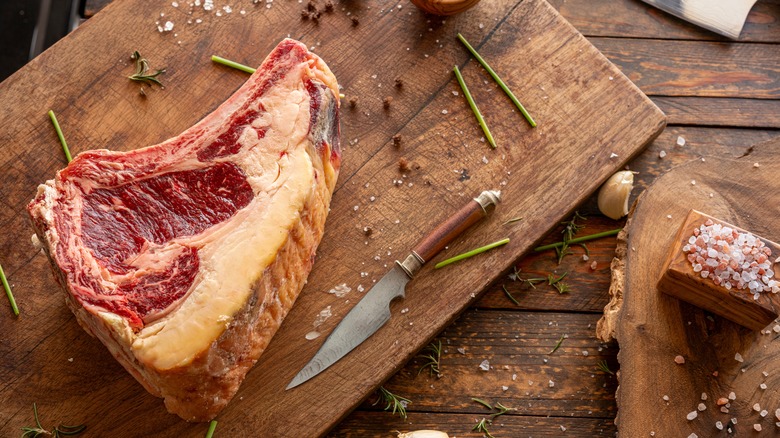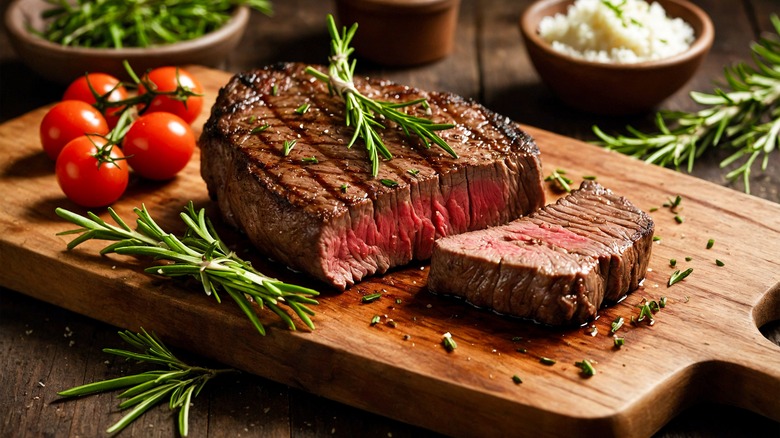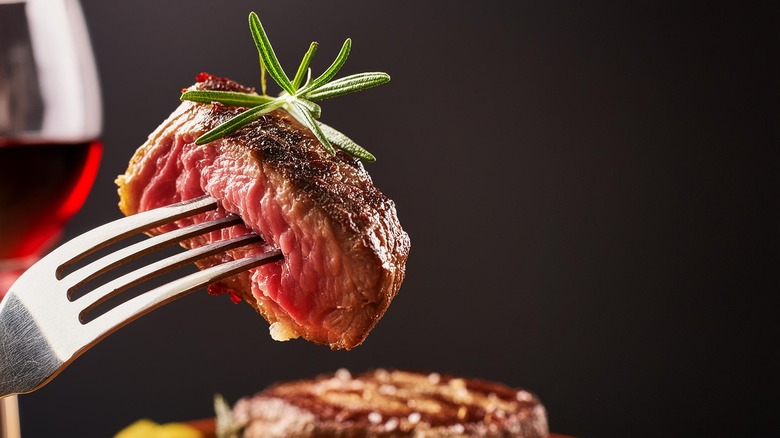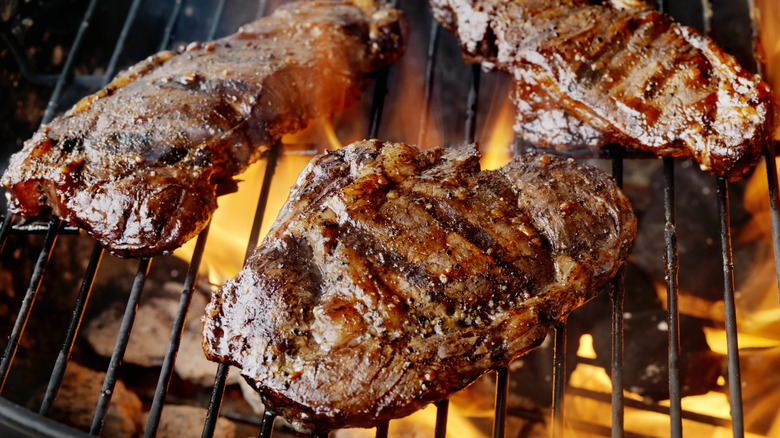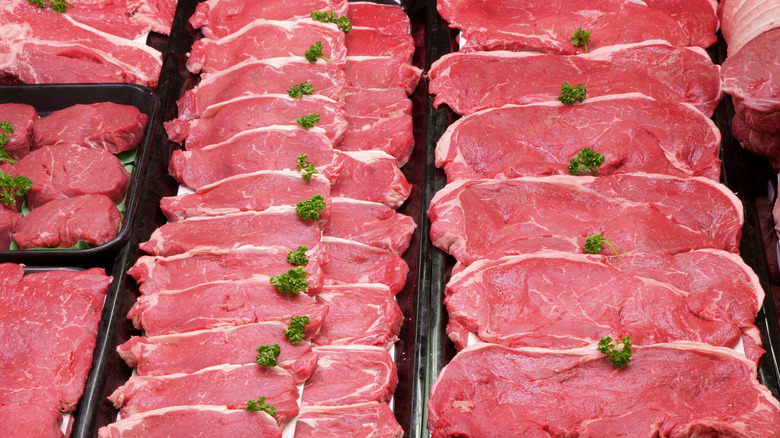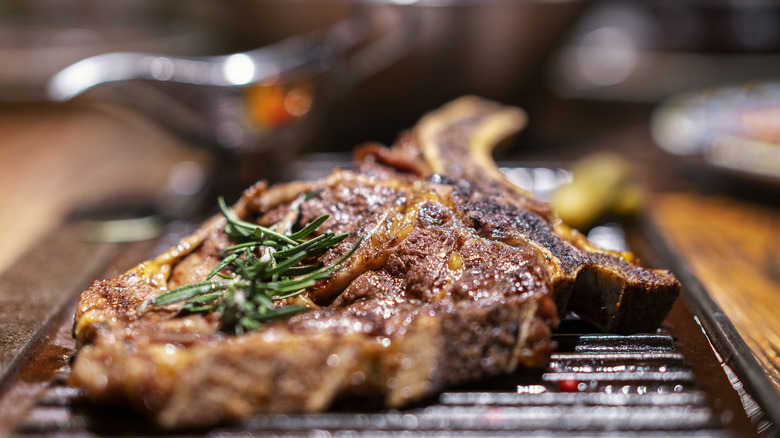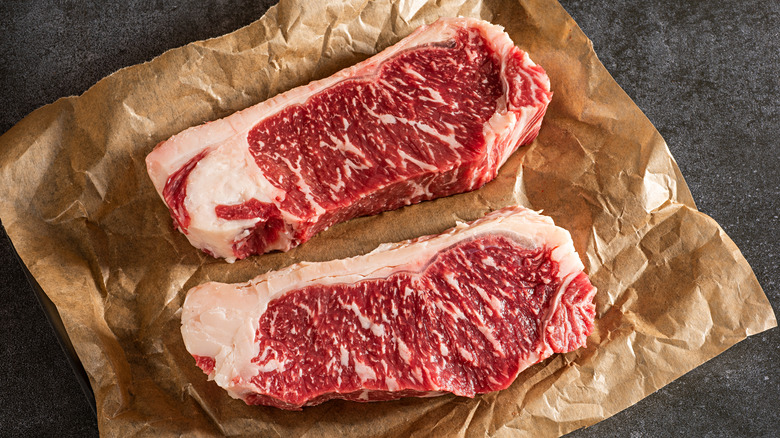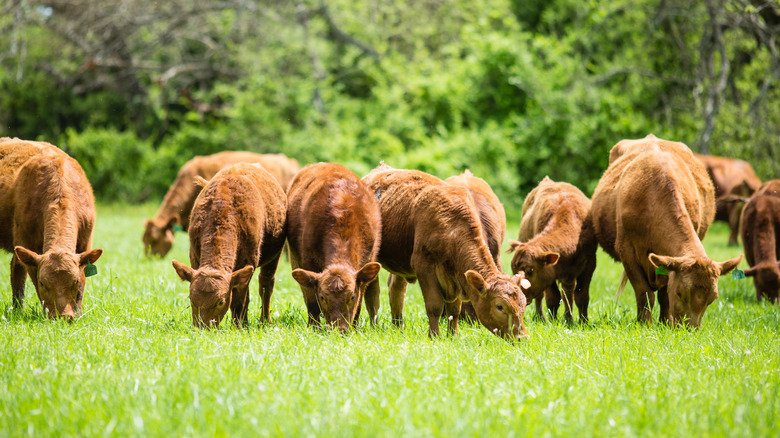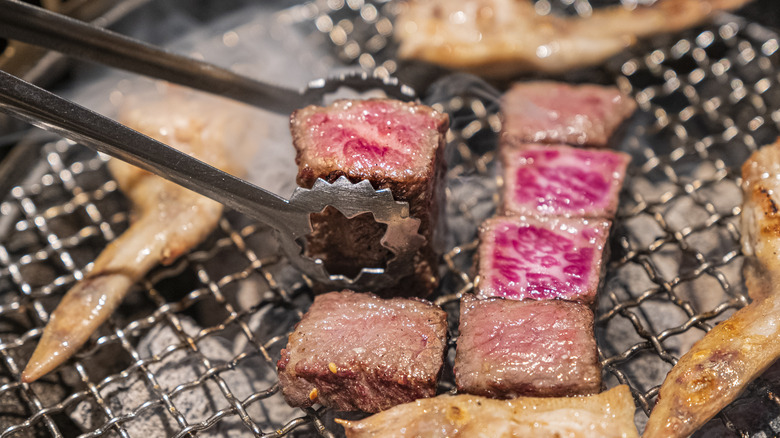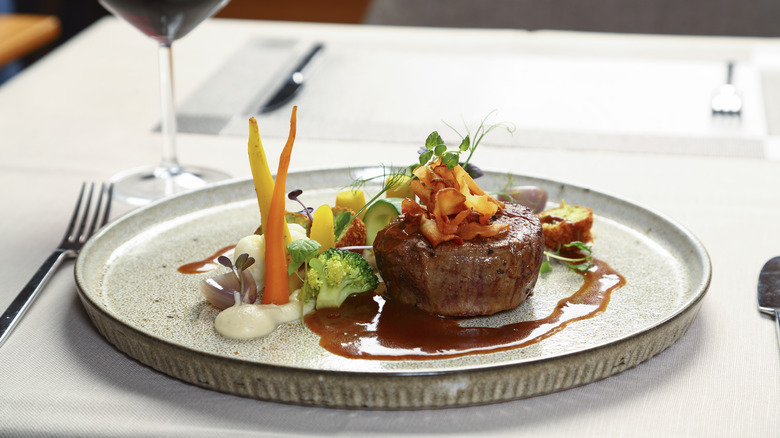11 Ways To Tell If You Are Eating A Cheap Steak
Steak is often a treat, something you look forward to with anticipation. But not all steaks are created equal. Whether you're dining at a restaurant or cooking at home, it can be hard to tell whether what's on your plate is worth the price tag. While a higher price doesn't always guarantee quality, there are some telltale signs that separate a premium cut from a cheaper one. Recognizing these distinctions can make all the difference between savoring every bite and feeling like you've been shortchanged.
It's important to note that not every inexpensive steak should be dismissed. "A cheap steak is not a bad steak," chef Cassie Ramsey exclusively tells Chowhound. "A Chuck Eye is jokingly called the poor man's ribeye and is absolutely delicious." Many affordable cuts can still deliver fantastic flavor and tenderness when cooked properly. But how can you tell if a steak is simply affordable or if it's genuinely low in quality?
With insight from seasoned chefs, we'll share what you should be looking for when it comes to marbling, fat content, texture, and more. Whether you're an experienced steak lover or just looking to learn more, you'll walk away with practical tips to help you distinguish a top-notch cut from a lower-grade one.
Lack of marbling indicates lower quality
Marbling, or the amount of white fat that appears in a cut of steak, is essential for both tenderness and flavor. And when it comes to more affordable cuts, marbling becomes even more critical. Insufficient marbling can result in a tougher, less satisfying piece of beef that fails to meet your flavor cravings.
As chef Cassie Ramsey tells Chowhound, "A higher-quality cut of beef likely has more marbled fat and will end up more tender when properly cooked and rested." Ramsey further explains, "The more marbling, the happier the cow. Generally, more marbling is associated with higher-quality beef. It contributes to the flavor, tenderness, and juiciness of the steak." Those delicate veins of fat melt during cooking, enriching the meat and resulting in a truly mouthwatering dish.
The bottom line is, when you're choosing a steak, keep an eye out for those enticing white streaks across the meat. Ideally, they'll be evenly distributed throughout the cut rather than just along the edges. Their presence or lack thereof can be a clear indicator of the quality of the meat you're about to eat.
Dull or off-color fat can be a red flag
Fat is not only essential for flavor — its color can also be a strong indicator of the quality of the steak. "The color of the fat should be a nice creamy white and distributed evenly throughout the cut of steak," James Beard-nominated chef Deborah VanTrece, owner of Twisted Soul Cookhouse & Pours in Atlanta, exclusively tells Chowhound.
So when you're at the store picking up a steak, avoid cuts with dull or yellowing fat, as this could indicate lower quality or even spoilage. Improper storage can easily alter the appearance of fat. Exposure to air can lead to oxidation, resulting in a dull or brownish hue and diminishing the meat's overall freshness.
That said, not all yellow fat is bad news. When it comes to aged steaks, for instance, the fat can naturally take on a slightly yellowish tint, and that's totally fine, according to Chef Cassie Ramsey. Aged beef often has enhanced flavor and tenderness, although its appearance may differ from what you expect with fresh cuts. But when it comes to a fresh steak, a hallmark of quality is fat that is creamy and white.
Grayish color suggests the meat is less than fresh
The color of the meat itself is another factor in steak quality and can often reveal whether a cut is less desirable. Fresh beef should have a bright, vibrant red hue. If you encounter a steak that appears gray or dull, proceed with caution. As Chef Cassie Ramsey bluntly says, "You are not thinking about the customer if that gray slab from the walk-in makes it to the table."
Gray meat can be a sign of a couple of things. For one, it can indicate that the steak has not been handled properly, potentially sitting out for too long or being stored at the wrong temperature. This can compromise flavor and texture, making it less appealing. What's more, the overall quality of the animal can play a role in the meat's appearance. If the cows were raised in suboptimal conditions, this can lead to grayish tones in the meat. The breed, diet, and farming practices can directly impact the meat's marbling and color. Well-cared-for cattle typically yield brighter, richer-colored cuts that are more tasty, especially when handled properly.
While slight discoloration may occur naturally when meat is exposed to oxygen, a consistently gray or dull appearance across the entire cut often indicates poor animal practices or inadequate care, both of which are common with cheaper options. In other words, always be vigilant about color — it's a straightforward way to gauge the quality of the steak before you even start cooking.
Tough or chewy texture could mean a cheaper cut
A steak's texture can reveal a lot about its quality. Chef Cassie Ramsey emphasizes that a high-quality steak should have a "buttery" texture, delivering a tender, melt-in-your-mouth experience. However, preferences for texture can vary widely among steak lovers. For instance, "Some people hate the chew of a ribeye or bavette and prefer the density of a New York strip," notes Ramsey. Regardless, when assessing a steak, be cautious of tough or excessively chewy textures, as these can be indicators of a lower-quality cut.
Cheaper steaks often come from older animals or those raised in less-than-ideal conditions, where factors like inadequate nutrition and stressful environments lead to tougher meat that lacks flavor. Additionally, muscle structure plays a significant role in texture and overall steak quality. Cuts from more active muscles, such as those found in the shoulder or leg, are generally firmer and require more effort to chew.
It's also worth noting that cooking methods can impact the texture of a steak. High-heat techniques, such as grilling or broiling, may amplify toughness in lesser-quality cuts, as can overcooking. At the end of the day, everyone has their own steak preferences, but knowing how texture affects quality is key. A tough or chewy steak not only detracts from the meal but can also indicate a lack of care and attention, like the kind that goes into premium cuts of steak.
Uneven cooking could mean lower meat quality
Uneven cooking can be a clear indicator of lower meat quality, often stemming from cuts that are on the cheaper side. Higher-quality cuts, such as ribeye or filet mignon, typically have a more consistent thickness and even fat distribution. This allows them to cook uniformly, resulting in that perfect sear and enticing crust that elevates the flavor and eating experience. "When cooking your steak, it should cook evenly, sear easy, and not dry out too fast," says Chef Deborah VanTrece.
On the other hand, cheaper cuts are usually sourced from tougher sections of the animal, leading to irregular shapes or inconsistent fat marbling. These inconsistencies can create hot spots while cooking, causing some parts of the steak to become overcooked while others remain underdone. This uneven cooking not only compromises the texture but can also detract from the overall flavor, making for a less satisfying meal. Next time you're shopping for steak, keep in mind that cuts with consistent thickness and good marbling tend to be of higher quality, ensuring more even cooking and a tastier meal.
Thin-cut steaks are not usually worth the cost savings
The thickness of a steak can be a telltale sign of what you're really getting in terms of quality. Thin-cut steaks like flank, skirt, or minute steak are often notably cheaper, making them an appealing option if you're trying to save a few bucks. However, opting for these cuts can sometimes lead to disappointment in terms of flavor and tenderness. As Chef Cassie Ramsey points out, "I hate a thin-cut steak. That tells me, especially as a restaurant, that they are getting the bang for your buck." So, while customers may feel like they're saving money, they're often paying more than the steak is worth, getting less value for their dollar compared to thicker, higher-quality cuts.
Thin-cut steaks tend to come from the less tasty parts of the animal, resulting in a meal that lacks the rich, juicy qualities of thicker cuts. For example, it would be exceedingly rare to see a thin-cut filet mignon. The quick cooking time of thinner steaks also means they can easily become overcooked, leaving you with a tough texture instead of the smooth, buttery texture you want. All of this is to say: beware thin cuts of steak. While they might seem like a wallet-friendly option, they may not be worth the cost savings. Instead, look for those hearty, thicker cuts that not only fill your plate but also satisfy your taste buds.
Overly lean steaks lack flavor and moisture
When it comes to choosing a high-quality steak, overly lean cuts are often not the best choice. While they are a slightly healthier option, they tend to lack the flavor and moisture that make a steak truly satisfying. As Chef Deborah VanTrece explains, "Fat melts during the cooking process and helps to add flavor and moisture."
This melting fat not only enhances the taste but also contributes to a juicy texture, transforming an ordinary cut into a delightful experience. Many leaner cuts come from less sought-after parts of the cow, such as the round or flank, which is why they often leave you wanting more in terms of flavor and texture. For a more enjoyable steak, reach for cuts like ribeye or sirloin, which offer a better balance of fat and flavor.
Chef Cassie Ramsey reinforces this point: "Cheaper cuts don't have the fat and don't retain moisture." The result? A dry, bland meal that's far from worth it. If you're trying to eat healthier, it might be better to skip steak altogether rather than sacrifice flavor by opting for a cut that's too lean. After all, when you decide to indulge in steak, the goal is to truly enjoy it and savor every delicious bite.
Cheaper steaks don't come from the loin of the cow
Steak quality is often tied to its source, and cheaper cuts typically come from parts of the cow that are less desirable. "The more expensive cuts of steak usually come ... from the loin section," says Chef Deborah VanTrece. "This is the part of the cow that represents the backside. This area doesn't get much of a workout, so the muscle isn't overused. Cuts from this area ... are very tender, flavorful, and cut like butter."
Chef Cassie Ramsey doubles down on this point. "The cut of steak significantly impacts its quality, with certain cuts being more desirable due to tenderness, flavor, and cooking versatility," she says. Tenderloin and New York strip are well-known examples of delicious loin cuts.
While non-loin cuts may not carry the same prestige, though, they can still deliver scrumptious results if cooked properly. "Hanger, skirt, and chuck are all great choices" for grounding, braising, or grilling, Ramsey says. Chef VanTrece adds that "cheaper cuts of beef, such as bavette, round steak, bottom sirloin, and tri-tip, when prepared the right way, can also be delicious." With the right techniques and seasonings, even less expensive cuts can shine. So, while the best steaks do come from the loin, don't underestimate the flavorful possibilities of cheaper cuts — they just require a bit more culinary creativity.
Factory-farmed beef is usually lower quality
The quality and price of beef is heavily influenced by farming practices, and factory-farmed beef often falls short of the standards for a truly great steak. "When I order steak at a restaurant, I always ask, where is the beef from?" Chef Deborah VanTrece says. "I try to purchase beef raised locally from small ranches as much as possible. Local beef is usually fresher and humanely raised, which generally is worth the extra few bucks it may cost." This insight highlights a growing trend among diners who prioritize quality and ethical sourcing.
Factory farming prizes quantity over quality, leading to a product that can be bland and less healthy. Cattle raised in crowded feedlots may not have access to pasture, affecting their health and the flavor of the meat. In contrast, cattle that are grass-fed and raised on small, local ranches produce beef of superior quality. According to Chef Cassie Ramsey, "Quality beef comes from cattle that are raised with care, often resulting in richer flavor and better marbling." This marbling, or intramuscular fat, is essential for flavor and tenderness.
Choosing locally sourced beef not only supports small farmers, but also often leads to a far superior dining experience. By seeking out high-quality, humanely raised options, you can ensure that your steak is both delicious and ethically sourced, making each bite worth every penny.
Certain cattle breeds lead to tougher, less flavorful steaks
The breed of cattle can also impact the price of the steak. "The more expensive cuts of steak usually come from top-breed cattle," chef Deborah VanTrece explains. Premium breeds like Angus, Wagyu, and Hereford are renowned for their marbling, tenderness, and rich flavor, making them ideal for high-quality steaks.
In contrast, cheaper steaks often originate from more common breeds such as Holstein, which is primarily raised for dairy, or Charolais, which can adapt to harsher environments. These breeds tend to produce tougher, less flavorful meat due to their leaner composition and lower marbling. Even the best cuts from these lesser breeds can end up subpar.
The differences in breed not only affect tenderness but also result in distinct flavor characteristics. Wagyu beef, for instance, is celebrated for its buttery texture and intense marbling, while Angus offers a robust, beefy flavor. Ultimately, opting for steaks from premium breeds like these guarantees a more flavorful and tender steak, setting them apart from even the highest-quality cuts from lesser breeds.
Too many ingredients on the plate may be hiding cheap meat
When dining out, a complex presentation could be a subtle cue that the meat is cheaper than advertised. Restaurants often use a multitude of ingredients to disguise cheaper cuts, chef Cassie Ramsey notes. "Presentation" and the "overuse of ingredients," like heavy sauces or elaborate garnishes, can indicate that the steak may not be of the highest quality, she says. "Cheaper cuts need marinade; they need all of the ingredients to make a steak taste beefy and delicious," Ramsey adds. If a steak is adorned with "all the bells, whistles, flowers, herbs, and sauces," it's wise to question the quality of the cut.
High-quality steak will shine on its own, needing little more than minimal seasoning or a light sauce to highlight its natural flavors. With that in mind, pay attention to how the steak tastes without all the extras — if it's tender and flavorful in a bare presentation, chances are it's a good cut. If not, it's clearly relying too much on those embellishments to mask its shortcomings.
